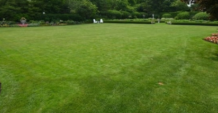Though soil tests are useful for identifying nutrient deficiencies as well as soil pH, they do not tell the whole story. We often receive soils from gardeners that are having a difficult time growing crops even though the soil test shows that nothing is deficient.
Here are some factors that can affect plant growth that are not due to nutrient deficiencies or pH.
Not enough sun: Plants need a certain minimum amount of sun before they will grow well. As a general rule, flowering (and fruiting) plants need at least 6 to 8 hours of full sun per day. There are, of course, exceptions such as impatiens that bloom well in shade. Move sun-loving plants out from the shade or use plants that are better adapted to shady conditions.
Improper watering: Roots develop where conditions are best for growth. Shallow, frequent watering leads to roots developing primarily near the surface of the soil where the soil is moist. Such shallow root systems are easily damaged by heat and any interruption in the watering schedule. It is better to water less frequently and to a greater depth to encourage a deeper root system that is less sensitive to heat and water stress.
Watering during the evening can also be detrimental to plants if the irrigation wets the foliage. Many diseases are encouraged by free water on the leaves. Watering late in the day often will keep the foliage wet until dew forms. Dew will keep the foliage wet until it evaporates the next morning. It is better to water early in the morning so leaves do not stay wet as long. If you must water late in the day, use drip irrigation if practical (such as in a vegetable garden).
Too much phosphorus: Most Kansas soils are naturally low in phosphorus. However, soils that have been fertilized for a number of years may have phosphorus levels that are quite high. As a matter of fact, the majority of soil tests we receive show phosphorus levels in the “high” category. Too much phosphorus can interfere with the uptake of some micronutrients such as iron, manganese and zinc.
High phosphorus soils should only be fertilized with fertilizers that have relatively low amounts of phosphorus.
Poor soil physical characteristics: Roots need oxygen as much as they need water. A tight clay soil can restrict soil oxygen levels as well as make root penetration of the soil difficult. Increasing the organic matter content of clay soils can help break them up. Add a 2-inch layer of organic matter and till it in.
Walnut trees: Walnuts give off a natural herbicide that interferes with the growth of some plants such as tomatoes. Vegetable gardens should be at least 50 feet away from walnut trees if possible. For a listing of plants that are susceptible to walnut, go to:
http://www.omafra.gov.on.ca/en
Tree roots: Trees not only compete with other plants for sun but also for water and nutrients. Extra water and nutrients may be needed.
Shallow soils: When new homes are built, the topsoil is often stripped off before the soils are brought to grade. Though the topsoil should be replaced, it sometimes is not or is not replaced to the same depth as it was originally. You are left with a subsoil that usually does not allow plants to grow well due to a lack of soil structure. Adding topsoil to a depth of 8 to 12 inches would be best but this often is notpractical. In such cases, try to rebuild structure by adding organic matter and working it into the soil. (Ward Upham)




